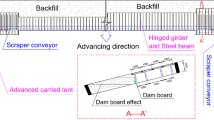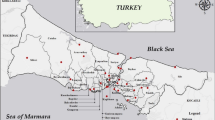Abstract
The Mogao Grottoes are among the most famous sites on the World Heritage list. Several large-scale preservation projects were implemented in 1962, 1982, and 2008, respectively, to improve their preservation conditions. According to field investigation and assessment in recent years, the cliff is stable on the whole because of the reinforcement projects. Among them, there are still 42 potentially dangerous bodies, which may not be stable in some conditions. For the purpose of building the monitoring and early warning system and the long-term preventive preservation of the Mogao Grottoes, an innovative analytical method based on the Analytic Hierarchy Process (AHP) and Fuzzy-AHP was applied to assess the hazard of potentially dangerous bodies within the cliff. Firstly, the hazard was classified into six groups: very high, high, moderate, low, very low, and no hazard, in this study. Secondly, the AHP method was applied to calculate the impact index of each causative factor, and then the hazard assessment of dangerous bodies was made based on statistical analysis. Finally, the Fuzzy-AHP method was applied to calculate the correlation of each factor and determine the comprehensive hazard class. The results indicate that Fuzzy-AHP seems to be more accurate than AHP in hazard assessment. Meanwhile, there is a very high risk body that can threaten 10 caves, three high risk bodies that can threaten 13 caves, and 15 moderate risk bodies can threaten 69 caves in total, while the remaining bodies are defined as low or very low grades. Overall, the results of this study provide much data and a theoretical model in the construction of a monitoring and early warning system currently. Furthermore, the new numerical simulation method also holds the potential application to assess the hazards of other types of heritage sites.












Similar content being viewed by others
References
Akgun A, Dag S, Bulut F (2008) Landslide susceptibility map** for a landslide-prone area (Findikli, NE of Turkey) by likelihood-frequency ratio and weighted linear combination models. Environ Geol 54:1127–1143
Akgun A, Sezer EA, Nefeslioglu HA, Gokceoglu C, Pradhan B (2012) An easy-to-use MATLAB program (MamLand) for the assessment of landslide susceptibility using a Mamdani fuzzy algorithm. Comput Geosci 38:23–34
Aleotti P, Chowdhury R (1999) Landslide hazard assessment: summary review and new perspectives. Bull Eng Geol Environ 58:21–44
Anbalagan R (1992) Landslide hazard evaluation and zonation map** in mountainous terrain. Eng Geol 32:269–277
Ayalew L, Yamagishi H (2005) The application of GIS-based logistic regression for landslide susceptibility map** in the Kakuda-Yahiko Mountains, Central Japan. Geomorphology 65:15–31
Ayalew L, Yamagishi H, Ugawa N (2004) Landslide susceptibility map** using GIS-based weighted linear combination, the case in Tsugawa area of Agano River, Niigata Prefecture, Japan. Landslides 1:73–81
Brabb EE (1984) Innovative approaches to landslide hazard map**. In: Proceedings 4th International Symposium on Landslides. Toronto, 1: 307–324
Carrara A, Cardinali M, Guzzeti F et al (1995) GIS technology in map** landslide hazard. Geographical information systems in assessing natural hazards. Kluwer Academic Publishers, Dordrecht, pp 135–175
Dai FC, Lee CF, Zhang XH (2001) GIS-based geo-environmental evaluation for urban land-use planning: a case study. Eng Geol 61:257–271
Demir G, Aytekin M, Akgün A, İkizler SB, Tatar O (2013) A comparison of landslide susceptibility map** of the eastern part of the North Anatolian Fault Zone (Turkey) by likelihood-frequency ratio and analytic hierarchy process methods. Nat Hazards 65:1481–1506
Dou J, Yamagishi H, Pourghasemi HR, Yunus AP, Song X, Xu Y, Zhu Z (2015) An integrated artificial neural network model for the landslide susceptibility assessment of Osado Island, Japan. Nat Hazards 78:1749–1776
Ercanoglu M, Gokceoglu C (2004) Use of fuzzy relations to produce landslide susceptibility map of a landslide prone area (West Black Sea Region, Turkey). Eng Geol 75:229–250
Ercanoglu M, Kasmer O, Temiz N (2008) Adaptation and comparison of expert opinion to analytical hierarchy process for landslide susceptibility map**. Bull Eng Geol Environ 67:565–578
Feizizadeh B, Roodposhti MS, Jankowski P, Blaschke T (2014) A GIS-based extended fuzzy multi-criteria evaluation for landslide susceptibility map**. Comput Geosci 73:208–221
Feng L, Zhu X, Sun X (2014) Assessing coastal reclamation suitability based on a fuzzy-AHP comprehensive evaluation framework: a case study of Lianyungang, China. Mar Pollut Bull 89:102–111
Gorsevski PV, Gessler PE, Jankowski P (2003) Integrating a fuzzy k -means classification and a Bayesian approach for spatial prediction of landslide hazard. J Geogr Syst 5:223–251
Gorsevski PV, Jankowski P, Gessler PE (2006) An heuristic approach for map** landslide hazard by integrating fuzzy logic with analytic hierarchy process. Control Cybern 35:121–146
Guo Q-l, Wang X-d, Zhang H-y, Li Z-x, Yang S-l (2009) Damage and conservation of the high cliff on the Northern area of Dunhuang Mogao Grottoes, China. Landslides 6:89–100
Guzzetti F, Carrara A, Cardinali M, Reichenbach P (1999) Landslide hazard evaluation: a review of current techniques and their application in a multi-scale study, Central Italy. Geomorphology 31:181–216
Hasekioğulları GD, Ercanoglu M (2012) A new approach to use AHP in landslide susceptibility map**: a case study at Yenice (Karabuk, NW Turkey). Nat Hazards 63:1157–1179
Kayastha P, Dhital MR, De Smedt F (2013) Application of the analytical hierarchy process (AHP) for landslide susceptibility map**: a case study from the Tinau watershed, west Nepal. Comput Geosci 52:398–408
Kouli M, Loupasakis C, Soupios P, Vallianatos F (2010) Landslide hazard zonation in high risk areas of Rethymno Prefecture, Crete Island, Greece. Nat Hazards 52:599–621
Kumar R, Anbalagan R (2015) Landslide susceptibility zonation in part of Tehri reservoir region using frequency ratio, fuzzy logic and GIS. J Earth Syst Sci 124:431–448
Leung LC, Cao D (2000) On consistency and ranking of alternatives in fuzzy AHP. Eur J Oper Res 124:102–113
Li Z-x (2002) The rock features of the Grottoes along the old silk road and its consolidation in conservation. Dunhuang Res 4:74–83 (in Chinese)
Ma F-s, Wang J, Yuan R-m, Zhao H-j, Guo J (2013) Application of analytical hierarchy process and least-squares method for landslide susceptibility assessment along the Zhong-Wu natural gas pipeline, China. Landslides 10:481–492
Nefeslioglu HA, Sezer EA, Gokceoglu C, Ayas Z (2013) A modified analytical hierarchy process (M-AHP) approach for decision support systems in natural hazard assessments. Comput Geosci 59:1–8
Park S, Choi C, Kim B, Kim J (2013) Landslide susceptibility map** using frequency ratio, analytic hierarchy process, logistic regression, and artificial neural network methods at the Inje area, Korea. Environ Earth Sci 68:1443–1464
Peng L, Xu S, Hou J, Peng J (2014) Quantitative risk analysis for landslides: the case of the Three Gorges area, China. Landslides 12:943–960
Poudyal CP, Chang C, Oh HJ, Lee S (2010) Landslide susceptibility maps comparing frequency ratio and artificial neural networks: a case study from the Nepal Himalaya. Environ Earth Sci 61:1049–1064
Pourghasemi HR, Moradi HR, Aghda SMF (2013) Landslide susceptibility map** by binary logistic regression, analytical hierarchy process, and statistical index models and assessment of their performances. Nat Hazards 69:749–779
Pradhan B, Sezer EA, Gokceoglu C, Buchroithner MF (2010) Landslide susceptibility map** by neuro-fuzzy approach in a landslide prone area (Cameron Highland, Malaysia). IEEE Trans Geosci Remote Sens 48:4164–4177
Saaty TL (1980) The analytic hierarchy process: planning, priority setting, resource allocation. McGraw-Hill Book Co, New York, p 287
Shi Y-c, Xu H-p, Wang X-d (2000) Seismic safety evaluation of Mogao Grottoes in Dunhuang. Dunhuang Res 1:49–55 (in Chinese)
Soeters R, van Westen CJ (1996) Slope instability recognition, analysis and zonation. Landslide: Investigation and Mitigation. Special Report 247. Transportation Research Board, National Research Council, Washington DC, pp 129–177
Varnes DJ (1984) International association of engineering geology commission on landslides and other mass movements on slopes: landslide hazard zonation: a review of principles and practice. UNESCO, Paris, p 63
Wang X-d, Zhang M-q, Zhang H-y, Zeng Z-z, Yao Z, Zhou Z-h (2000) Engineering properties of surrounding rocks of Mogao Grottoes at Dunghuang. Chin J Rock Mech Eng 6:756–761 (in Chinese)
Yalcin A, Reis S, Aydinoglu AC, Yomralioglu T (2011) A GIS-based comparative study of frequency ratio, analytical hierarchy process, bivariate statistics and logistics regression methods for landslide susceptibility map** in Trabzon, NE Turkey. Catena 85:274–287
Zadeh LA (1973) Outline f a new approach to the analysis of complex systems and decision processes. IEEE Trans Syst Man Cybern SMC-3(1):28–46
Zhang M-q, Wen L-i, Wang X-d, Guo Q-l, Shi Y-c (2009) Impact of construction vibration on Mogao Grottoes in Dunhuang. Chin J Rock Mech Eng 28(supp 2):3762–3768 (in Chinese)
Acknowledgments
This work is supported by the National Twelfth Five-Year Plan Science and Technology Support Program of China (Study on the key technologies of risk monitoring and assessment in Dunhuang Mogao Grottoes, grant No. 2013BAK01B01). We would like to express our gratitude. The results of this work are based on the data collected in Dunhuang Academy and the field investigation is also supported by them. We want to thank all the members who gave us lots of help and cooperation.
Author information
Authors and Affiliations
Corresponding author
Rights and permissions
About this article
Cite this article
Guo, Z., Chen, W., Zhang, J. et al. Hazard assessment of potentially dangerous bodies within a cliff based on the Fuzzy-AHP method: a case study of the Mogao Grottoes, China. Bull Eng Geol Environ 76, 1009–1020 (2017). https://doi.org/10.1007/s10064-016-0865-7
Received:
Accepted:
Published:
Issue Date:
DOI: https://doi.org/10.1007/s10064-016-0865-7




